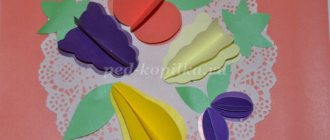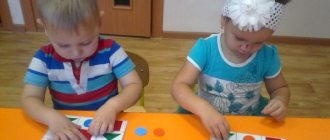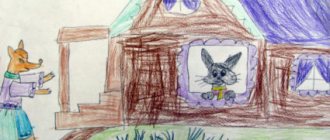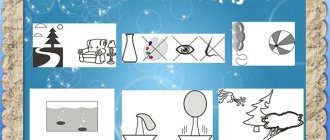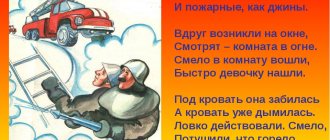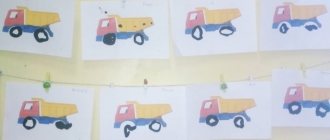Senior group. Senior preschool age. Children 5-6 years old
Lesson summary for children of the senior group “City for Lego men” “City for
Lego men ” (senior group)
Educational areas: artistic and aesthetic development.
Integration of activities: cognitive - research, gaming, communicative. Lexical topic: “A city for
Lego men ” Type of activity: collective -…
Abstract of the OOD "Travel with Dunno" using a Lego constructor in the senior group. Abstract of an OOD using a Lego constructor in the senior group . Topic “Transport”
“Travel with Dunno”
Objectives: Develop interest in creating variable
designs from Lego material . Update your understanding of different types of transport, the ability to systematize objects...
GCD for Lego construction “Building a house” lesson plan (middle group)
Scenario of educational activities
(middle group)
Topic: “Building a house”
Integration of activities (cognitive - research activities, communicative, constructive).
Goal: Development of children’s cognitive activity in the process of organizing constructive-model activities
Tasks:
Educational (aimed at developing the child’s competencies):
- to form in preschoolers an idea about building a house;
- vocabulary replenishment
Developmental (aimed at developing mental processes, including speech):
- Develop interest in constructive modeling activities.
- Continue to introduce Lego and model with it.
- Develop fine motor skills of the hands.
Educational (aimed at developing personal qualities and interpersonal relationships):
- Foster activity, initiative, and independence.
- Develop the ability to finish what you start.
Tools, equipment, materials:
visual (demonstration material): presentation, diagrams, Lego men, technological map for assembling a house
handouts: Lego constructor
Technological map of educational activities
| № | Stage of educational activities | Progress of educational activities | ||
| Activities of a teacher | Children's activities | Ways to support children's initiative | ||
| 1. | INTRODUCTORY PART | |||
| Organizing time | (Music sounds) children enter the group and see a sick box -Hello guys, Do you know what or who is in this box? Today Lego men came to us and asked us for help. - Shall we help them? | (Children enter the group). -Hello! No Yes | Musical accompaniment; lego men; | |
| Problem situation (or motivation) and setting and acceptance by children of the goals of educational activities | -Lego men can't cope with building a house. They don't have any time left. Only one drawings - Who knows what a drawing is? — A drawing is a schematic drawing of knowledge or some kind of building. | Children's answers | The teacher shows the children sheets with the diagram | |
| 2. | MAIN PART | |||
| Designing solutions to a problem situation, updating knowledge, or starting to take action on the objectives of educational activities | -Let's look at the images. - Tell me, what is there at the house? — Pay attention to the screen. | Look at the images Walls, roof, windows, floors, stairs, doors Children see on the screen pictures of houses | House floor assembly illustrations; Working with a presentation Game for attention | |
| “Discovery” of new knowledge and ways of action by children | — What else must be done so that a person can get into his cozy home? Where will we use the biggest LEGO pieces? — What parts does the house itself consist of? Finger gymnastics to increase strength in the hands I will build a house. (Raise your hands above your head like a house) And there will be a window in it. (Join the thumbs and index fingers of both hands to form a rectangle) To make a beautiful entrance to it. (Turn your palms towards you and close them with the side ribs, straightening all your fingers) There will be a fence around (Place your hands in front of you in a ring, connecting your fingers) | entrance We use the largest construction parts for the base of the house. from medium and small construction kit parts | Finger gymnastics to music; conversation with children | |
| 2. | Independent application of new things in practice, or updating existing knowledge, ideas, (performing work) | Divide into pairs and sit at the tables. Each person has a set of parts and an assembly diagram on their desk. Assembling according to the diagram | Sit down at the tables Independent work according to the scheme | Parts kits |
| 3 | FINAL PART | |||
| The result of educational activities. Systematization of knowledge. | Now I suggest you now connect all the floors. - let's count how many floors we have - how many floors? | Connect I think 7 floors | ||
| Reflection | You have 3 emoticons on your tables, fill in the one that matches your mood and whether you liked the activity | Execute | Joyful mood; | |
Open lesson on Lego construction
.
Subject:
Design of houses, urban landscape.
Goal:
To get acquainted with the housing of different peoples and nationalities, the basic concepts of the urban landscape, to recall the features of urban buildings.
Development of the ability to follow the teacher’s instructions; Development of children's constructive imagination; Development and activation of children's speech; Formation of the ability to work in small groups; To develop an aesthetic taste for architecture. Equipment:
LEGO DUPLA sets in sufficient quantities, images of the city landscape, homes of different peoples.
Progress of the lesson
LEGO warm-up
Guys, before we start our lesson, let's choose a captain in each group.
The teacher gives commands in which the children must take a piece of a certain color and connect it with a certain piece. (The result of the work is a figure similar to a house). The work is done in a circle, starting with the team captain.
Conversation
What does the resulting model look like? On house.
Listen to the riddle:
Where is our family comfortable? Where does it smell like porridge in the morning? (Houses)
What do you think we will talk about in our lesson today? About the house.
What should a house be like?
Housing should not only be comfortable, but also durable, adapted to living conditions.
Imagine that you have the necessary building material at your disposal. The question involuntarily arises of how to build, because any business must have its own laws and methods. Have you ever wondered why most houses are rectangular in shape? Acute and obtuse angles are almost never used in construction, except in some decorative structures. Some peoples prefer round dwellings: igloos, yurts? To answer these questions, let’s take a closer look at the dwellings of different peoples.
- Villages
— the settlement of the mountaineers resembles swallow’s nests. Dwellings are located one next to the other and one above the other (Tajiks, Uzbeks, Chechens) of Central Asia and the Caucasus.
In the Caucasus mountains, especially in Dagestan, an aul is a fortified settlement. Houses in auls are usually built of stone on a mountain slope or against a steep wall to protect the settlement from unexpected attacks. Houses are usually two-story.
Most often, villages are located near rivers or lakes.
2. Yurts
- the inhabitants of the steppe made a house from felt. (Mongols, Kazakhs, Tatars) Many peoples of Central and Central Asia lived in yurts. For nomadic tribes, this is a very convenient house that can be easily disassembled and transported. The main place in the yurt was occupied by the hearth. Taking a closer look, you realize that the round shape of the home is the most comfortable and rational, allowing everyone to sit around the hearth. In the center of the yurt, a hoop was fixed to four pillars, which was connected to the frame using poles. A hole was left in the cone-shaped roof through which light entered the yurt and smoke came out. The outside of the frame was tied with ropes for stability and then covered with felt. This material is very convenient to use: in cold weather it reliably protects from frost, and when moving, it can be rolled up and placed in a bale. Felt was also used to cover the floors in the yurt.
3. Plagues, yarangas
- houses made of fur, hunters and reindeer herders of the North are the inhabitants of such houses. (Chukchi, Nenets, Nanai) The dwelling of the Evenks - chum - is striking in its simplicity. Its basis is made up of three poles connected at the top. Another 30-50 thinner poles rest on them. The tent is covered with elk skins. True, not everyone could afford such luxury. Those who were poorer made do with larch bark. In the warm season, the tent was covered with boiled birch bark.
The largest and most spacious tent belonged to the shaman, at whose place all the inhabitants of the camp gathered.
Igloo is a round house made of large sharpened pieces of ice (Eskimos).
As we can see, every nation built houses from the material at hand. What did the inhabitants of the Far North do, where there is only snow around and it is difficult to find a twig or stone? They build their houses - igloos - from snow. After all, snow not only cools, but also warms. It keeps the home warm and prevents frost from penetrating inside. Over time, snow buildings do not collapse, but rather become stronger. The wind helps, depositing new layers of snow on the needle. From the inside, under the influence of people's breath, ice forms, which serves as a frame for the home.
The igloos are heated with a candle or a fat lamp. However, people do not freeze and even strip naked in their “house”.
In what houses did our ancestors live and live now? (In wooden houses, huts).
And now what kind of houses do we live in? (wooden, multi-story)
- Where are these multi-storey buildings built?
- Why build high-rise buildings in the city? (Saves space, there are a lot of people)
- Are there such houses in our city?
- What is located in small, one-story buildings? (Shops, cafes, pharmacies...)
- What else besides houses and various buildings is there in our city? (Squares, stadiums, parks...)
- Why do the townspeople need all this?
- What do city dwellers lack? (More trees, parks...)
- What can you and I do to improve our life in the city? (Protect nature)
- Who should work to build such a house? Name the construction professions. (Builders: painter, carpenter, tiler, roofer, electrician, plumber, plasterer, crane operator, architect, mason, bulldozer operator, excavator operator, etc.).
And with a person, what profession does the construction of a house begin with? (Architect).
Today we will play the role of an architect.
Now we need to build our own mini project. Each group will have its own task (to build a high-rise building, a one-story building, a square or a playground), after which the commanders of each group must defend their work, tell what you built and for whom.
Commanders choose a mission.
Remember that buildings, streets, avenues, boulevards, parks, squares make cities beautiful
Independent work with the designer
Children are divided into 3 teams:
1 team builds city high-rise buildings; 2 team urban small houses; 3 team park or playground;
Defense and discussion of the resulting projects
Abstract of NNOD light engineering on the topic “City”
Summary of GCD on Lego construction for children of the preparatory group
on the theme "City"
Target
Developing children's ability to visually model through LEGO construction sets.
Educational
objectives :
— To develop the ability to convey the features of objects using the LEGO constructor.
— Strengthen children’s ability to build according to a model.
Educational:
— Develop constructive abilities and a sustainable interest in design.
— Develop fine motor skills and hand-eye coordination.
— Develop visual and effective thinking.
— Develop visual and spatial perception.
— Develop the ability to carry out elementary analysis of objects, to identify the whole and parts.
Educational:
— To develop in children the ability to work in a team of peers, helping each other in joint construction.
— Foster respect for the work of adults. Preliminary work:
talking with children about the construction profession, looking at illustrations of house buildings, observing houses while walking. Reading fairy tales “Teremok”, “The Three Little Pigs”; stories by B. Zakhoder “Builders”, S. Baruzdin “Who built this house”; working together with children with LEGO constructors.
Methods and techniques:
gaming, visual, verbal, practical activities for children.
Materials and equipment:
Visual:
model of a city made from LEGO (without houses): city residents, cars; LEGO DUPLO construction set, sample building for children, house diagram for each child; presentation for children
Multimedia:
laptop, TV; presentation for children, musical accompaniment.
Progress of the lesson
GCD move:
The teacher and children enter the group, stand in a circle, and join hands.
Educator: Let's stand side by side, in a circle,
Let's say "Hello!" each other.
We are too lazy to say hello:
Hi all!" and “Good afternoon!”
If everyone smiles -
Good morning will begin.
Guys, let's say hello and smile at each other. (Children greet each other.)
Educator: Children, today I received an unusual letter from residents of the city of Solnechny. Let's read it together. (Children approach the screen; it shows a picture of Lego men). The teacher reads the letter: “Guys, trouble has happened in our city! We woke up in the morning, went outside and saw that all the houses in our city had disappeared! Help us, please, build houses for our city!”
II. Educator: Children, let's help the residents of the city of Solnechny? (Children's answers).
First, let's remember who builds houses. What is the name of the profession of a person who builds houses? Guess the riddle:
He puts the bricks in a row,
He is building a kindergarten for the children.
Not a miner or a driver,
He will build us a house...
Answer: Builder
Educator: Since ancient times, one of the most necessary professions in our world has been the “Builder” profession. In order to live, work, study well, people need a roof over their heads. And not only the roof, but also walls, windows, doors and many other things that are made for us by real craftsmen, united by the common profession of “builder”.
Educator: Children, let's remember what parts the house consists of? (Children's answers)
Where does the construction of a house begin? Construction of a house begins with pouring the foundation, the foundation is the basis of the entire building, it must be very strong and durable. The foundation is the lowest part of the house structure, located in the ground. The task of this always invisible part is to transfer the entire load from the house to the ground. Simply put, the foundation is the “legs” of the house, its supporting part.
The next part of the house is the walls. The walls are made of various materials: brick, logs, concrete, stone.
When the walls are ready, a roof is put on the house. The roof must be strong so that not a single drop of rain leaks through it. And of course, to ensure that the house is always light and warm, windows and doors are installed.
Educator: And now we will remember what tools a builder needs to build a house.
Didactic game “Pick up the tools.” Children are given cards with pictures of various instruments. Children must choose and correctly name the necessary tools.
Educator: Well done, children, you did the task well. Let's take a little rest and warm up. (Physical training is held under the video)
Finger gymnastics
“Home”. Starting position: hands clenched into fists, leaving round holes inside.
We place the fist on the fist, changing the position of the hands several times - we get a long “pipe”. The house has a large chimney.
You and I will live in it. The chimney on the roof looks up and smokes as if it is breathing. Connect your fingers at an angle, place your thumbs one on top of the other.
Straighten the index finger of one hand - this is a “pipe”. Look at the house with the chimney.
You and I will live in it. Raise your arms above your head, connect your fingers at an angle.
Here stands a huge house, Yes, terribly important. A hundred windows in that house! It's multi-story.
Educator: Now we can begin building houses for the residents of the city of Solnechny. Children, come to the table. (On the table there is a box of Lego and a covered model of a street with little people.) The teacher removes the covered building.
Educator: Guys, look, this is the same city. There really are no houses on it, only residents. And here is the material we need, from which we will build houses. What is it called? (Children's answers) Let's try to build a house together. First we put the foundation, then the walls, now we put the roof, don’t forget about the windows and doors. Our first house is ready!
Educator: And now I suggest you build the same house. Sit at the table. In front of you are the parts of the designer, from these parts you will build a house yourself. You can start.
While the children are making houses, light music plays. The teacher helps if the child does not succeed.
III. Educator: Our houses are ready. Now we can place them in the city. What a great fellow you are! What wonderful houses you have built! Residents of the city of “Solnechny” are very glad that now there is order in their city and they can live in their homes again! They send you a big thank you!
The children go to the screen on which the Lego people thank the children.
Educator. I ask you guys to evaluate your work.
If you liked the lesson, you succeeded - pick up the green construction brick.
If you didn’t like something or something didn’t work out for you, pick up the yellow construction brick.
(Children pick up the required construction brick).
Educator. Thank you very much for the lesson. See you again!
